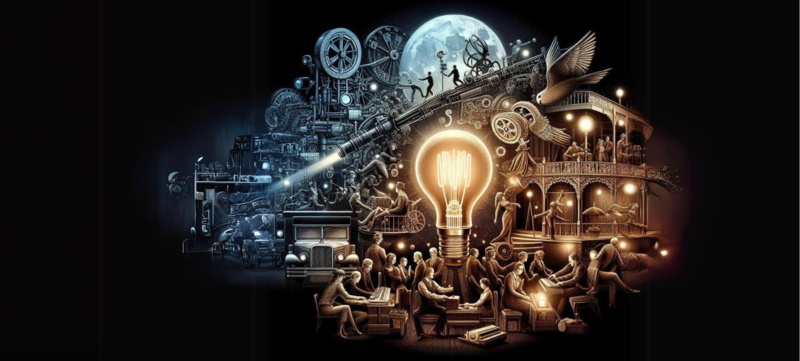'Change is the only constant'. Heraclitus said it 2,500 years ago, and this phrase still resonates with us today. We must look back and see that what was one way yesterday is now another. There is change, Instead, each of us decides how to face it and act in the face of its immediate presence.
By Miguel Colton
I like to understand the relationship between art and technology as a bidirectional one. As John Lasseter, former creative director of Pixar, notes: 'Art challenges technology, and technology inspires art.' This is how we see that artistic evolution is not inconsistent with technological development. In fact, they complement and enhance each other in a symbiotic relationship.
Let's travel together to the middle of the 19th century, when the streets of the main cities of Spain already had gas lamps, instead of the oil lamps that lit them a few decades earlier. Theaters were the axis of the artistic and social life of those cities, and on any given day, the best artists of the moment, with the most careful costumes and magnificent curtains painted under the light of steric candles, and, the next day, the same theater could be engulfed in flames.
This devastating story took place in hundreds of theaters, museums or libraries across the territory. The evolution of lighting technology and different ways of lighting a venue have made it possible to improve the safety of theaters, in addition to achieving truly spectacular stage effects.
As Steve Jobs said: 'Technology is a tool, but it's the people who make the magic.' Therefore, it is our responsibility to use technology tools to enhance our experience. That's why I want to share with you three ways technology and art go hand in hand.
Technology in Art Creation
We travel for a moment to 1953 and enter the Sanford Museum in Cherokee (USA), where local mathematician and artist Ben F. You can see the first computer-generated work thanks to Labosky. Now, seventy years later, digital art is integrated into our lives. What difference do you see to Labosky's work? Portrait of Edmund de BellamyThe first frame designed with artificial intelligence?
The democratization of technology has allowed more people to access previously elitist media, and this has translated into more opportunities for creation. The important thing is, in the words of Albert Einstein, 'the human spirit must prevail over technology.' The art object should be more important than the tools we use to achieve it.
An example of technology used in music is found in this Lab Band In the RTVE Orchestra and Choir, they performed the first symphony composed by artificial intelligence.
Should we test the capabilities of new technological tools to discover where new limits lie?
Technology in Arts Management
In fact, the tools we have today for organizing tasks, communicating with our teams, accounting, and general art management activities have changed a lot in recent decades. And they keep changing.
Also, some pilot projects have been developed in Spain in recent years Vigos oh GlissandoIt allows detailed management for music groups.
We can see similar projects in other areas of operation ArchAIDEAnd Software Developed for the automatic recognition of archaeological ceramic shards, it was designed with the aim of speeding up recognition tasks from an image of a ceramic shard. The application is not intended to replace the work of experts, but rather to help identify the typology of findings in a much faster and more versatile way.
Technology of cultural consumption
There is no doubt about the revolution that has come from having a device at hand capable of connecting us to the world from anywhere. This is why many cultural institutions are looking for ways to improve their proposals by integrating the use of mobile phones with artistic experiences.
For example, in museums, visitors are not content to observe a work or installation as passive subjects, use a traditional audio guide, or read static information collected in writing next to the work or location. Audiences demand dynamic, visual and interactive content.
Augmented reality (AR) is an example of technology that allows the integration of the physical world with digital content. Casa Batllo Gaudi's great architectural experience from Barcelona was able to immerse him in his thoughts and life.
Technology engages the audience and induces a unique experience, and it brings art and culture closer to society, making museums, libraries or theaters accessible to citizens who do not normally frequent them, and allowing them to see and enjoy them. A distance through your computer or mobile phone.
In this sense, it came to light long ago Google Art Project, a website that lets you take virtual tours of some of the world's most prestigious museums and discover works of art from all corners of the planet. In recent years, there are many museums and theaters that have created virtual tours that allow anyone to see first-hand the places and cultural contents offered there.

